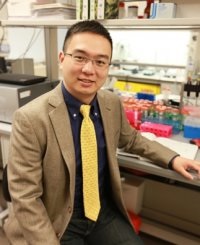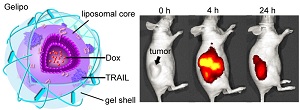 |
| Zhen Gu |
Two birds with one stone? How about two drug targets with one delivery vehicle? Researchers in North Carolina have developed a single nanoparticle capable of carrying two separate drugs to two different locations in a cancer cell. The aim is to program the delivery in such a way that maximizes the efficiency of each drug.
The nanoparticles developed at North Carolina State University and the University of North Carolina at Chapel Hill consist of an outer shell and an inner core, each with different components to hold the cancer drugs. The shell, for instance, is made of a crosslinked gel that can safely hold the tumor necrosis factor-related apoptosis-inducing ligand (TRAIL) protein, which acts on the death receptor of the cancer cells' membranes. And the core carries tiny liposomes filled with the cancer drug doxorubicin.
The whole system, in the very early stages, is designed to act on breast cancer cells in mice, for now. The research was published in the Jan. 2 issue of Advanced Functional Materials.
The way this works--from targeting to release--is entirely dependent on the composition of the shell, lead author Zheng Gu of NC State told FierceDrugDelivery. The shell is made of cross-linked hyaluronic acid, or HA, which has multiple functions. Structurally, it protects both drugs, including the very fragile TRAIL protein from denaturing before it reaches the target, and also the toxic doxorubicin contained within the core. The HA also homes in on the tumor environment, which is rich in the enzyme HAase that "eats" the HA shell away "like Pac-Man," Gu said.
 |
| The structure of the nanoparticle with a gel shell containing a cancer-killing protein and an inner core containing cancer drug liposomes showed increased efficiency in mouse models.--Courtesy of NC State |
"HA can recognize the tumor and is a targeting mechanism," Gu said. "And HA is degraded at the tumor site as the enzymes there bind and eat away the HA. At this point, the large proteins, which were stabilized by the matrix, can access the cancer cell membrane and the doxorubicin can enter the cell.
"The whole system is programmed like a robot to deliver the stuff to the right spot," Gu added.
Overall, the two-drug approach shows to increase the efficiency of the treatment, resulting in a 5.9-fold increase in cytotoxicity, according to the abstract.
Gu and his team, which focuses specifically on drug delivery, began working on this particular system two years ago, he said, and they have looked at the nanoparticles to treat both cancer and diabetes in a programmed way.
"Now we want to optimize our formations," Gu said. "We hope to be working in large mammals as soon as possible, and to be in the clinic in three to 5 years. For me, personally, I have cancer patients in my family, so I think it's really encouraging to be this close."
- here's the NC State report
- and here's the Advanced Functional Materials abstract